Experimental and Numerical Study on the Insulation Performance of a Photo-Thermal Roof in Hot Summer and Cold Winter Areas
Abstract
:1. Introduction
2. Methods
2.1. Experimental Model
2.2. Experimental Measurements
2.3. Mathematical Model
2.3.1. Heat Transfer Analysis
2.3.2. The Effective Thermal Conductivity of the Roof’s Insulation Material
2.4. Simulation Conditions
2.5. Simulation Verification
3. Results and Discussion
3.1. Experimental Results and Analysis
3.2. Effect of Water Saturation
3.3. Effect of the Thickness of Roof Insulation Materials
3.4. Variation in the Average Water Temperature of the Collectors
4. Conclusions
Author Contributions
Funding
Institutional Review Board Statement
Informed Consent Statement
Data Availability Statement
Conflicts of Interest
Nomenclature
| C | Specific heat capacity of materials (J/(kg·K)) |
| D | Index of thermal inertia |
| E | The total energy composed of thermodynamic and kinetic energy (J/kg) |
| hg | Convective heat transfer coefficient of the glass cover (W/m2·K) |
| hi,w | convective heat transfer coefficient of the inner surface of each material layer (W/m2·K) |
| hj | Enthalpy of matter (kJ/kg) |
| ho,w | convective heat transfer coefficient of the outer surface of each material layer (W/m2·K) |
| I | Solar radiation intensity (W/m2) |
| JJ | Diffusion flux (kg/(m2·s)) |
| P | Pressure (Pa) |
| qc,b | Heat convection between the collector’s back surface and the air (W/m2) |
| qc,g | Heat convection between the glass cover and the external environment (W/m2) |
| qc,in | Heat convection between the roof inner surface and the indoor air (W/m2) |
| qc,out | Heat convection between the photo-thermal roof and the air (W/m2) |
| qcond | Conductive heat flux (W/m2) |
| Qw | Released heat by hot water (W) |
| qr,b | Heat radiation of the collector’s back surface to the roof (W/m2) |
| qr,g | Heat radiation of the glass cover to the external environment (W/m2) |
| qr,in | Heat radiation of the roof inner surface to the indoor environment (W/m2) |
| qr,out | Heat radiation of the roof to the collector’s back surface (W/m2) |
| Si | Thermal effusivity of wall inner surface (W/m2·K) |
| So | Thermal effusivity of wall outer surface (W/m2·K) |
| Sh | Heat source (W/m3) |
| Tb | Temperature of the back surface of the collector (℃) |
| Tg | The temperature of the glass cover (℃) |
| Tn | other surface temperatures in the room (℃) |
| Tsky | Sky temperature (℃) |
| Ti,a | The temperature of air in contact with the inner surface of the material layer (℃) |
| To,a | The temperature of air in contact with the outer surface of the material layer (℃) |
| Ti,w | The roof inner surface temperature (℃) |
| To,w | The roof outer surface temperature (℃) |
| αg | Absorptivity of the glass cover |
| αp | Absorptivity of the absorber plate |
| αw | Absorptivity of roof outer surface |
| αi,w | Heat transfer coefficient of wall inner surface (W/m2·K) |
| αo,w | Heat transfer coefficient of wall outer surface (W/m2·K) |
| λa | Thermal conductivity of air (W/(m·k)) |
| λe | Thermal conductivity of roof materials (W/(m·k)) |
| λec | Effective thermal conductivity of porous media satisfying serial heat conduction model (W/(m·k)) |
| λep | Effective thermal conductivity of porous media satisfying parallel heat conduction model (W/(m·k)) |
| λl | Thermal conductivity of liquid phase in porous media (W/(m·k)) |
| λp | Thermal conductivity of solar collectors (W/(m·k)) |
| λs | Thermal conductivity of solid phase in porous media (W/(m·k)) |
| εa | The volume percentage of the gas phase per unit volume (%) |
| εb | Emissivity of the collector rear cover |
| εg | Emissivity of the glass cover |
| εi,w | Emissivity of the roof inner surface |
| εo,w | Emissivity of the roof outer surface |
| τ | Unit time |
| τg | Transmissivity of the glass cover |
| φ | Water saturation (%) |
| σ | The Boltzmann constant, σ = 5.67 × 10−8 W/(m2·K4) |
| ϕ | Time lag |
References
- Zhou, N.; Price, L.; Yande, D.; Creyts, J.; Khanna, N.; Fridley, D.; Lu, H.; Feng, W.; Liu, X.; Hasanbeigi, A.; et al. A roadmap for China to peak carbon dioxide emissions and achieve a 20% share of non-fossil fuels in primary energy by 2030. Appl. Energy 2019, 239, 793–819. [Google Scholar] [CrossRef]
- IEA. Online Data Services. 2019. Available online: https://www.iea.org/buildings (accessed on 20 February 2022).
- Lu, X.; Memari, A.M. Comparison of the Experimental Measurement Methods for Building Envelope Thermal Transmittance. Buildings 2022, 12, 282. [Google Scholar] [CrossRef]
- International Energy Agency. Energy and Climate Change: World Energy Outlook Special Report 2015; International Energy Agency: Paris, France, June 2015. [Google Scholar]
- Nikkho, S.K.; Heidarinejad, M.; Liu, J.; Srebric, J. Quantifying the impact of urban wind sheltering on the building energy consumption. Appl. Therm. Eng. 2017, 116, 850–865. [Google Scholar] [CrossRef] [Green Version]
- Xin, Z.; Xw, M.; By, C.; Yp, S.; Ml, S. Challenges toward carbon neutrality in China: Strategies and countermeasures. Resour. Conserv. Recycl. 2021, 176, 105959. [Google Scholar]
- Li, H.; Zheng, R. Energy and Economic Performance of Solar Cooling Systems in the Hot-Summer and Cold-Winter Zone. Buildings 2018, 8, 37. [Google Scholar] [CrossRef]
- Notton, G. Tu1205 Projet Cost Overview of BISTS State of the Art, Models and Applications. COST Action TU1205 (BISTS): Building Integration of Solar Thermal Systems; European Cooperation in Science and Technology (COST): Brussels, Belgium, 2015. [Google Scholar]
- Celadyn, W.; Filipek, P. Investigation of the Effective Use of Photovoltaic Modules in Architectu re. Buildings 2020, 10, 145. [Google Scholar] [CrossRef]
- Piratheepan, M.; Anderson, T. Performance of a Building Integrated Photovoltaic/Thermal Concentrator for Facade Applications. Sol. Energy 2017, 153, 562–573. [Google Scholar] [CrossRef] [Green Version]
- Fekete, I.; Farkas, I. Numerical and experimental study of building integrated solar tile collectors. Renew. Energy 2018, 137, 45–55. [Google Scholar] [CrossRef]
- Deng, C.; Chen, F. Preliminary investigation on photo-thermal performance of a novel embedded building integrated solar evacuated tube collector with compound parabolic concentrator. Energy 2020, 202, 117706. [Google Scholar] [CrossRef]
- Lin, W.; Ma, Z.; Wang, S.; Sohel, M.; Cascio, E.L. Experimental investigation and two-level model-based optimisation of a solar photovoltaic thermal collector coupled with phase change material thermal energy storage. Appl. Therm. Eng. 2021, 182, 116098. [Google Scholar] [CrossRef]
- Pugsley, A.; Zacharopoulos, A.; Mondol, J.D.; Smyth, M. BIPV/T facades—A new opportunity for integrated collector-storage solar water heaters? Part 1: State-of-the-art, theory and potential. Sol. Energy 2020, 207, 317–335. [Google Scholar] [CrossRef]
- Harmim, A.; Boukar, M.; Amar, M.; Haida, A. Simulation and experimentation of an integrated collector storage solar water heater designed for integration into building facade. Energy 2018, 166, 59–71. [Google Scholar] [CrossRef]
- Gautam, K.R.; Andresen, G.B. Performance comparison of building-integrated combined photovoltaic thermal solar collectors (BiPVT) with other building-integrated solar technologies. Sol. Energy 2017, 155, 93–102. [Google Scholar] [CrossRef]
- Luo, K.; Ji, J.; Xu, L.; Li, Z. Seasonal experimental study of a hybrid photovoltaic-water/air solar wall system. Appl. Therm. Eng. 2019, 169, 114853. [Google Scholar] [CrossRef]
- Rahmani, F.; Robinson, M.A.; Barzegaran, M.R. Cool roof coating impact on roof-mounted photovoltaic solar modules at texas green power microgrid. Int. J. Electr. Power Energy Syst. 2021, 130, 106932. [Google Scholar] [CrossRef]
- Christoph, M.; Christoph, C.; Tilmann, E.K. Progress in building-integrated solar thermal systems. Sol. Energy 2017, 154, 158–186. [Google Scholar]
- Ahmed, S.; Li, Z.; Javed, M.S.; Ma, T. A review on the integration of radiative cooling and solar energy harvesting. Mater. Today Energy 2021, 21, 100776. [Google Scholar] [CrossRef]
- Yu, G.; Yang, H.; Yan, Z.; Ansah, M.K. A review of designs and performance of facade-based building integrated photovoltaic-thermal (BIPVT) systems. Appl. Therm. Eng. 2021, 182, 116081. [Google Scholar] [CrossRef]
- Shao, N.; Ma, L.; Zhang, J. Experimental study on electrical and thermal performance and heat transfer characteristic of PV/T roof in summer. Appl. Therm. Eng. 2019, 162, 114276. [Google Scholar] [CrossRef]
- Ponechal, R.; Barňák, P.; Ďurica, P. Comparison of Simulation and Measurement in a Short-Term Evaluation of the Thermal Comfort Parameters of an Office in a Low-Carbon Building. Buildings 2022, 12, 349. [Google Scholar] [CrossRef]
- Sourek, M.B. Façade solar collectors. Sol. Energy 2006, 80, 1443–1452. [Google Scholar]
- Buonomano, A.; Forzano, C.; Kalogirou, S.A.; Palombo, A. Building-façade integrated solar thermal collectors: Energy-economic performance and indoor comfort simulation model of a water-based prototype for heating, cooling, and DHW production. Renew. Energy 2018, 137, 20–36. [Google Scholar] [CrossRef]
- Chang, H.; Hou, Y.; Lee, I.; Liu, T.; Acharya, T.D. Feasibility Study and Passive Design of Nearly Zero Energy Building on Rural Houses in Xi’an, China. Buildings 2022, 12, 341. [Google Scholar] [CrossRef]
- Gao, Y.; Shi, D.; Levinson, R.; Guo, R.; Lin, C.; Ge, J. Thermal performance and energy savings of white and sedum-tray garden roof: A case study in a Chongqing office building. Energy Build. 2017, 156, 343–359. [Google Scholar] [CrossRef] [Green Version]
- Tong, S.; Li, H.; Zingre, K.T.; Wan, M.P.; Chang, W.C.; Wong, S.K.; Toh, W.B.T.; Lee, I.Y.L. Thermal performance of concrete-based roofs in tropical climate. Energy Build. 2014, 76, 392–401. [Google Scholar] [CrossRef]
- Barone, G.; Buonomano, A.; Forzano, C.; Giuzio, G.F.; Palombo, A. Passive and active performance assessment of building integrated hybrid solar photovoltaic/thermal collector prototypes: Energy, comfort, and economic analyses. Energy 2020, 209, 118435. [Google Scholar] [CrossRef]
- Long, J.; Jiang, M.; Lu, J.; Du, A. Vertical temperature distribution characteristics and adjustment methods of a trombe wall. Build. Environ. 2019, 165, 106386. [Google Scholar] [CrossRef]
- Bowen, B.D. “Heat transfer-A basic approach”, by M. Necati Öuzisik, 1985, 780 pages, mcgraw-hill book company, (U.S.). Can. J. Chem. Eng. 1988, 66, 1036–1037. [Google Scholar] [CrossRef]
- Zhou, J. Study on Microstructure and Energy Saving Characteristics of Rock Wool Board Used for Building External Wall Insulation System. Master’s Thesis, Chang’an University, Xi’an, China, 2018. [Google Scholar]
- GB50736-2012; Design Code for Heating Ventilation and Air Conditioning of Civil Buildings: GB50736-2012. China Architecture & Building Press: Beijing, China, 2012.
- Heat Transfer under Periodic Heat Action; China Architecture & Building Press: Beijing, China, 1964.
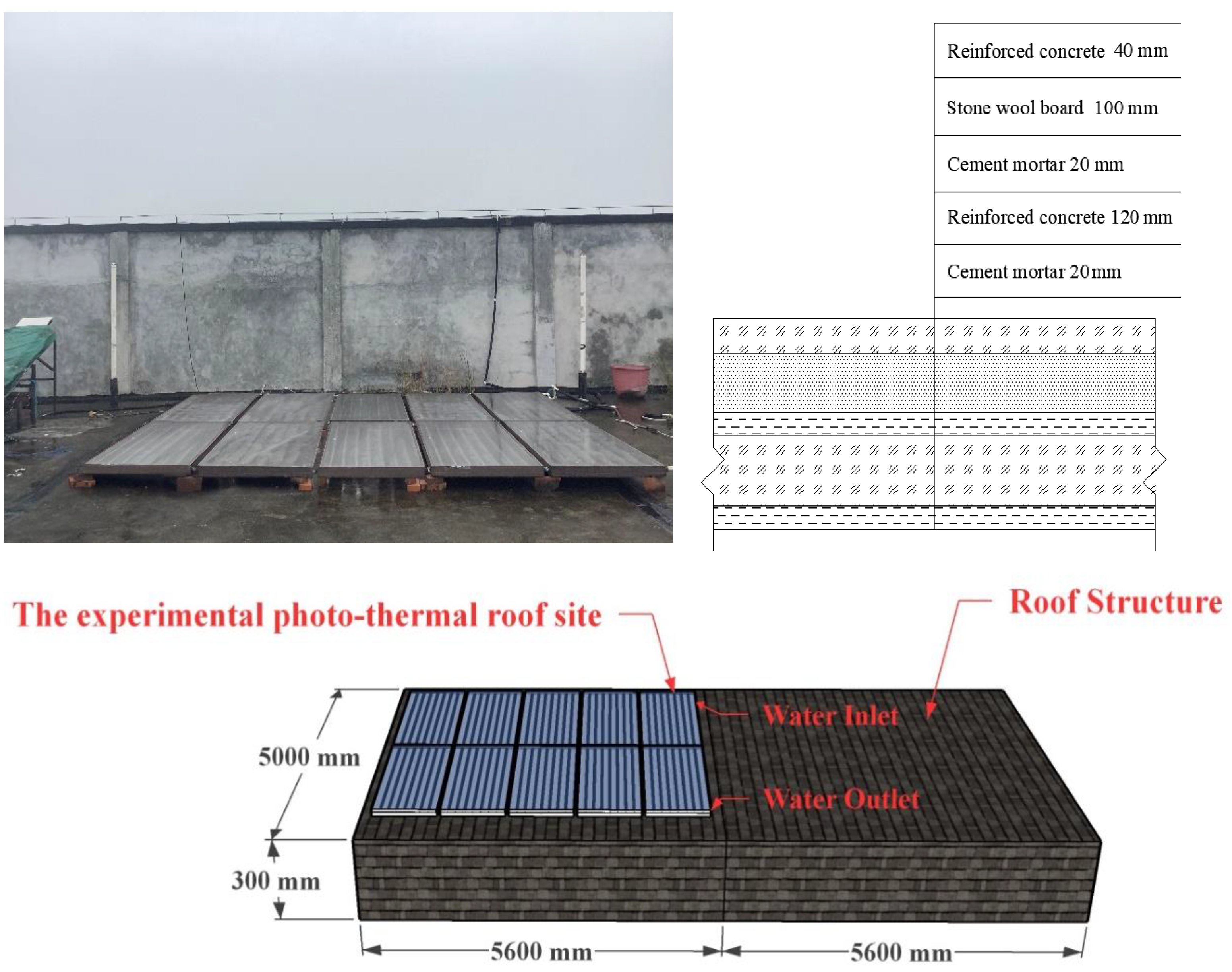
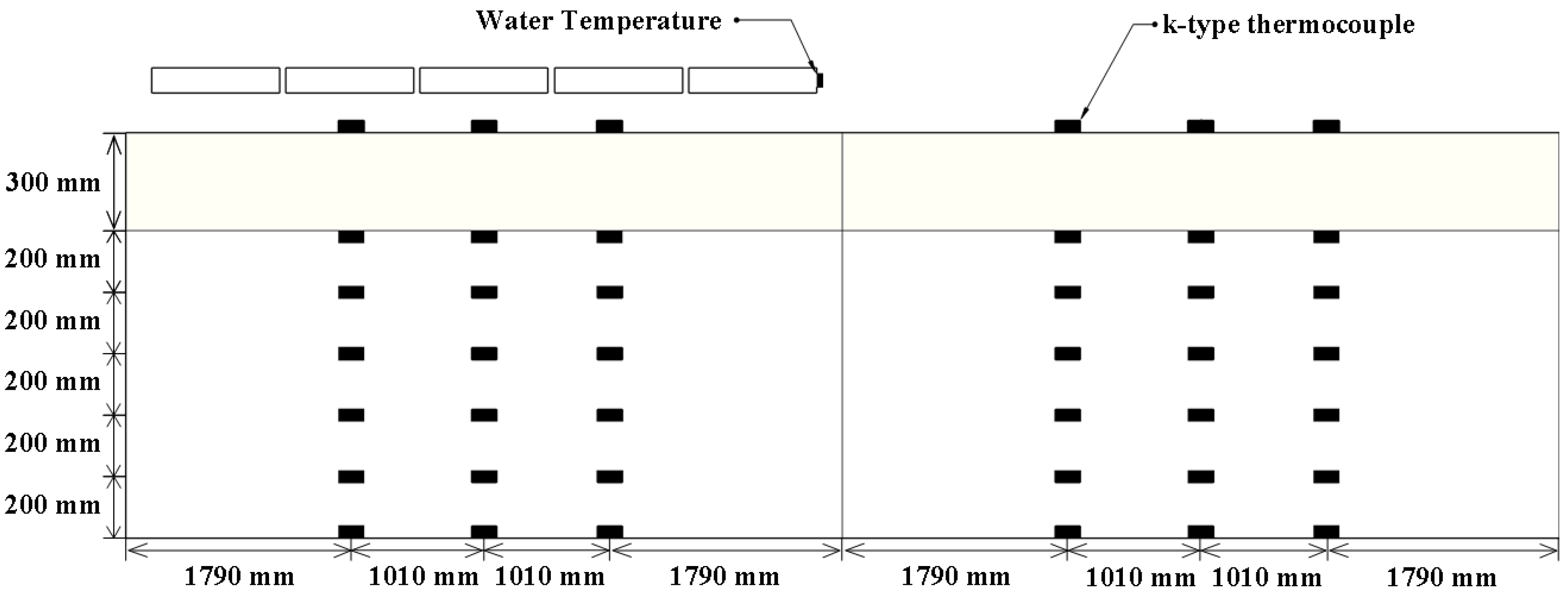

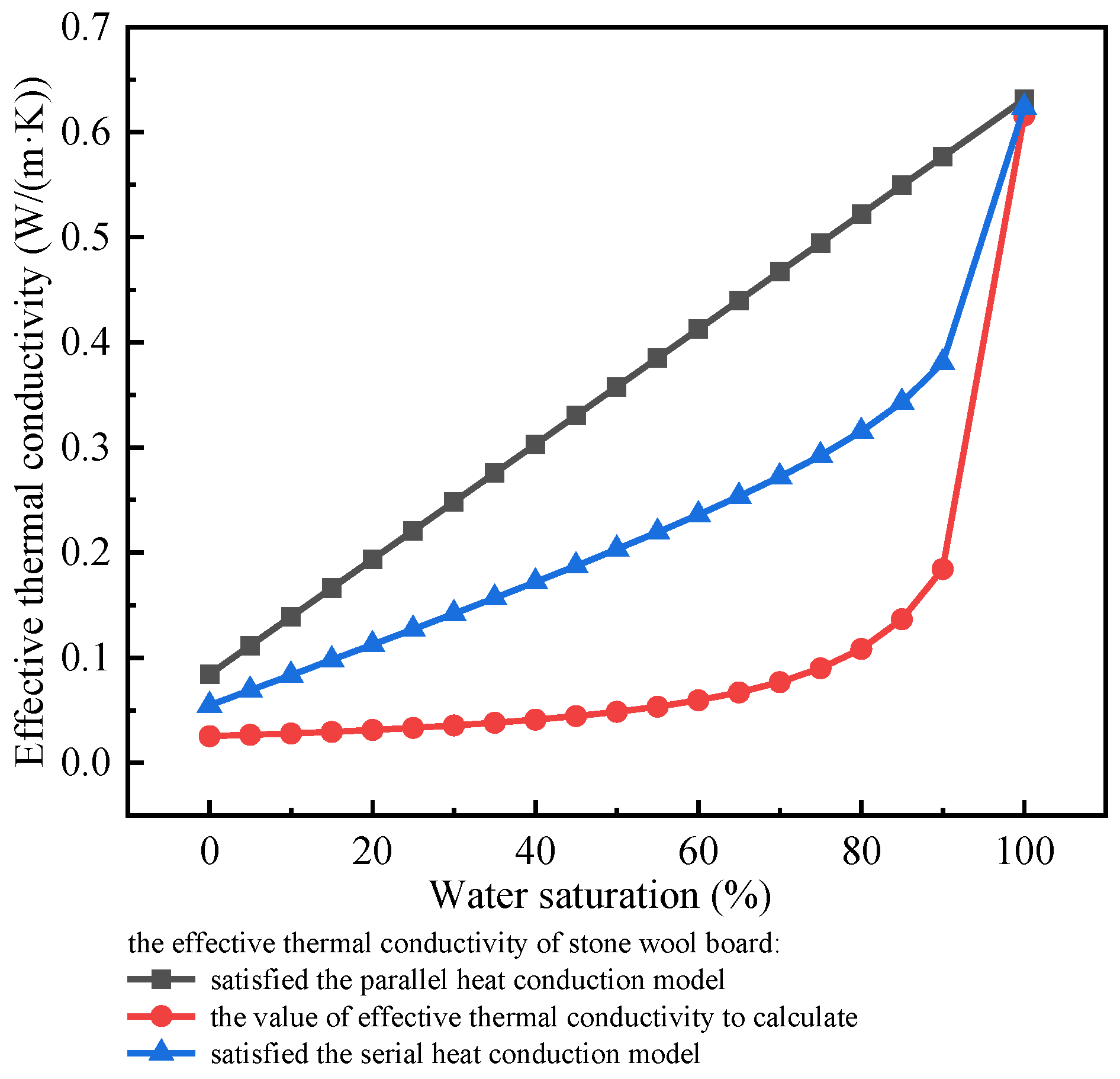

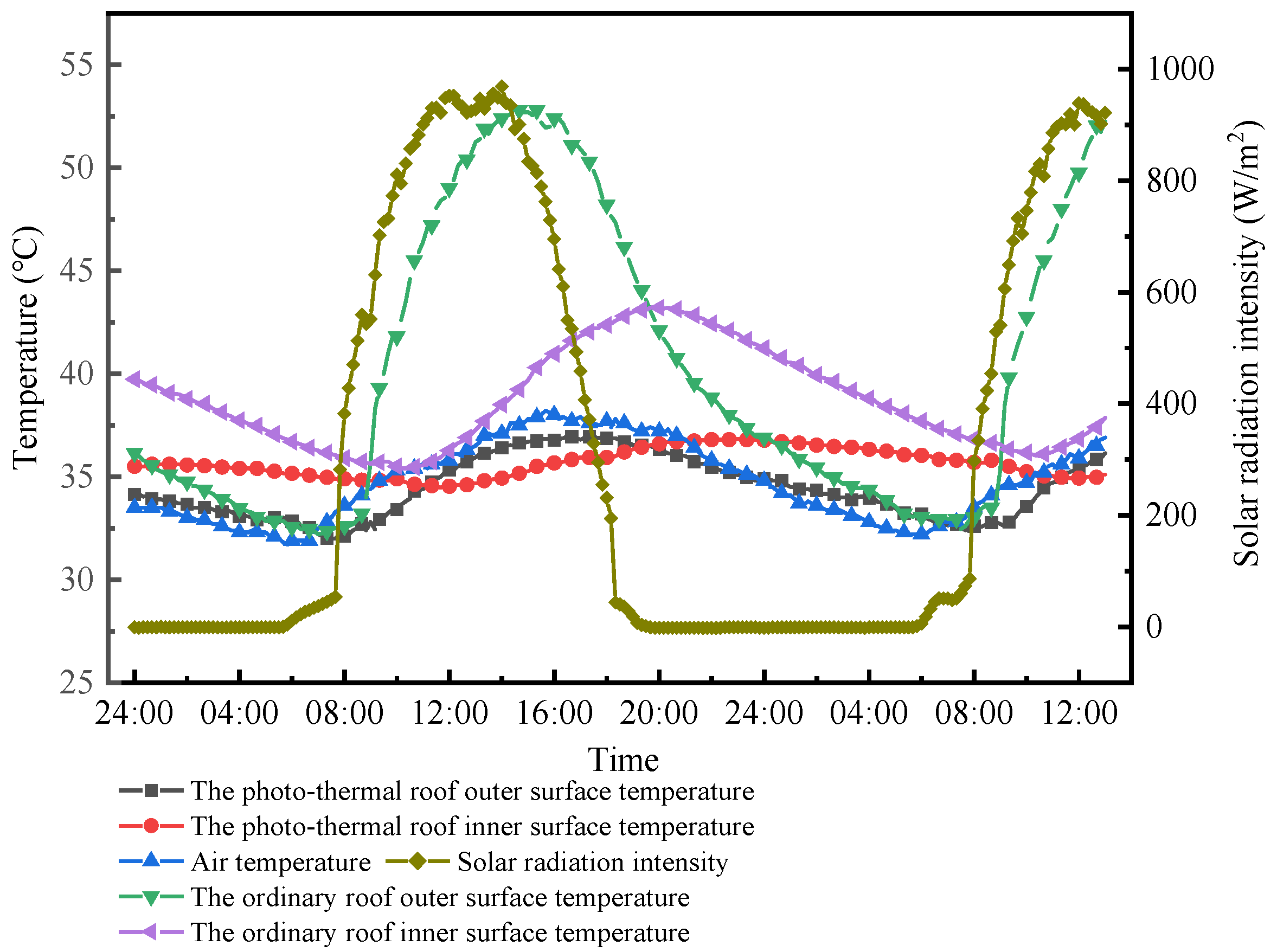
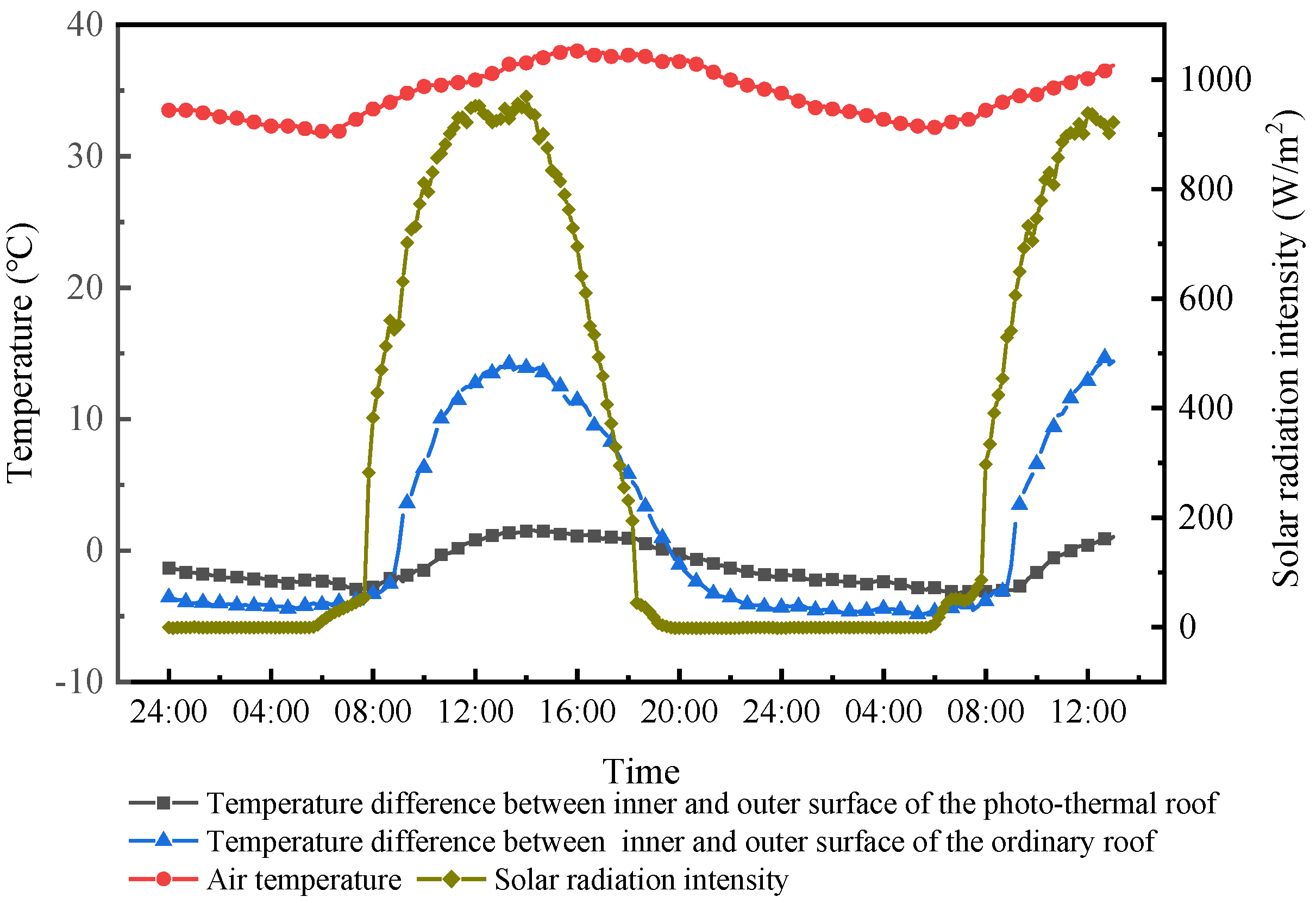
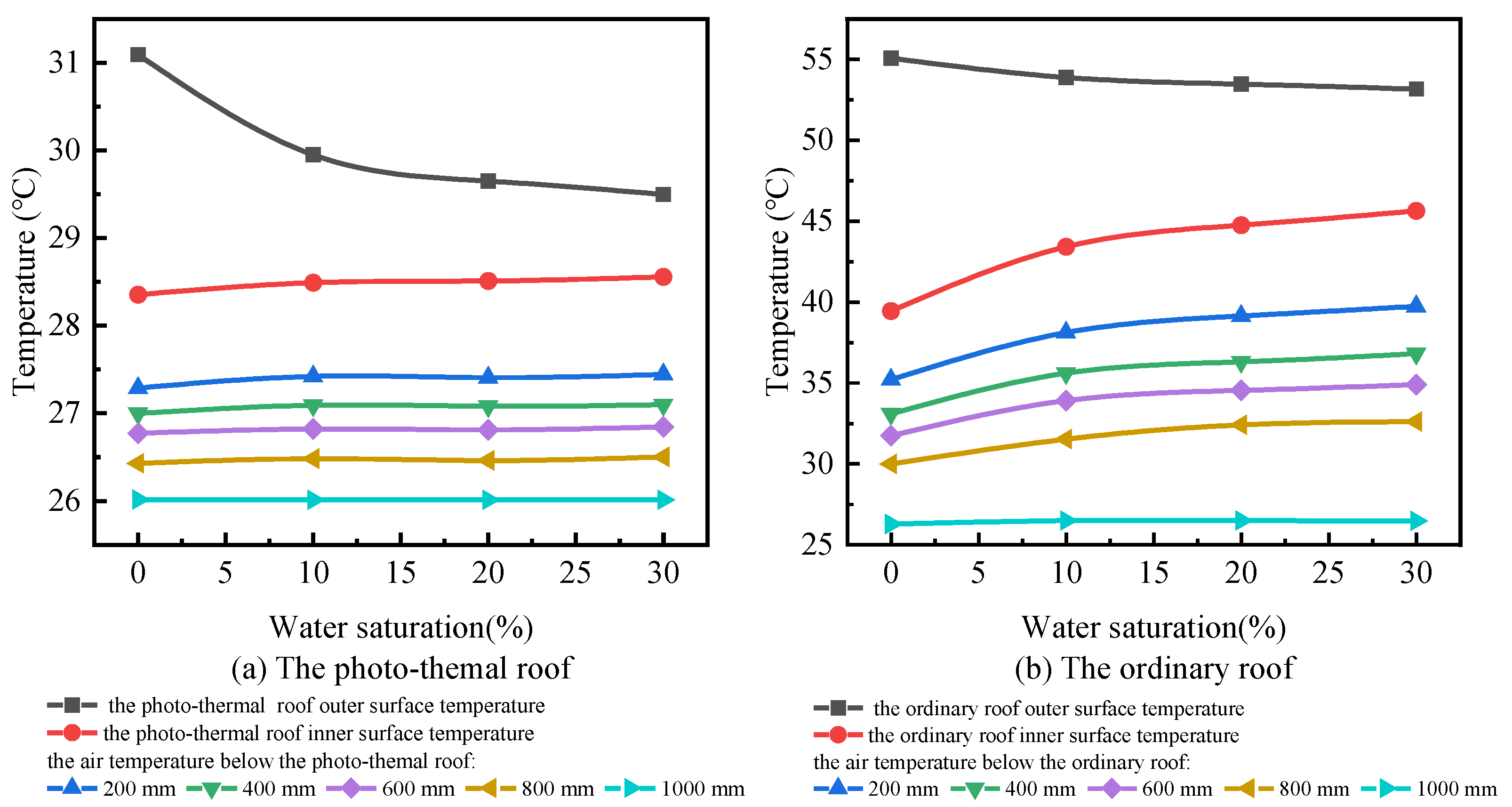

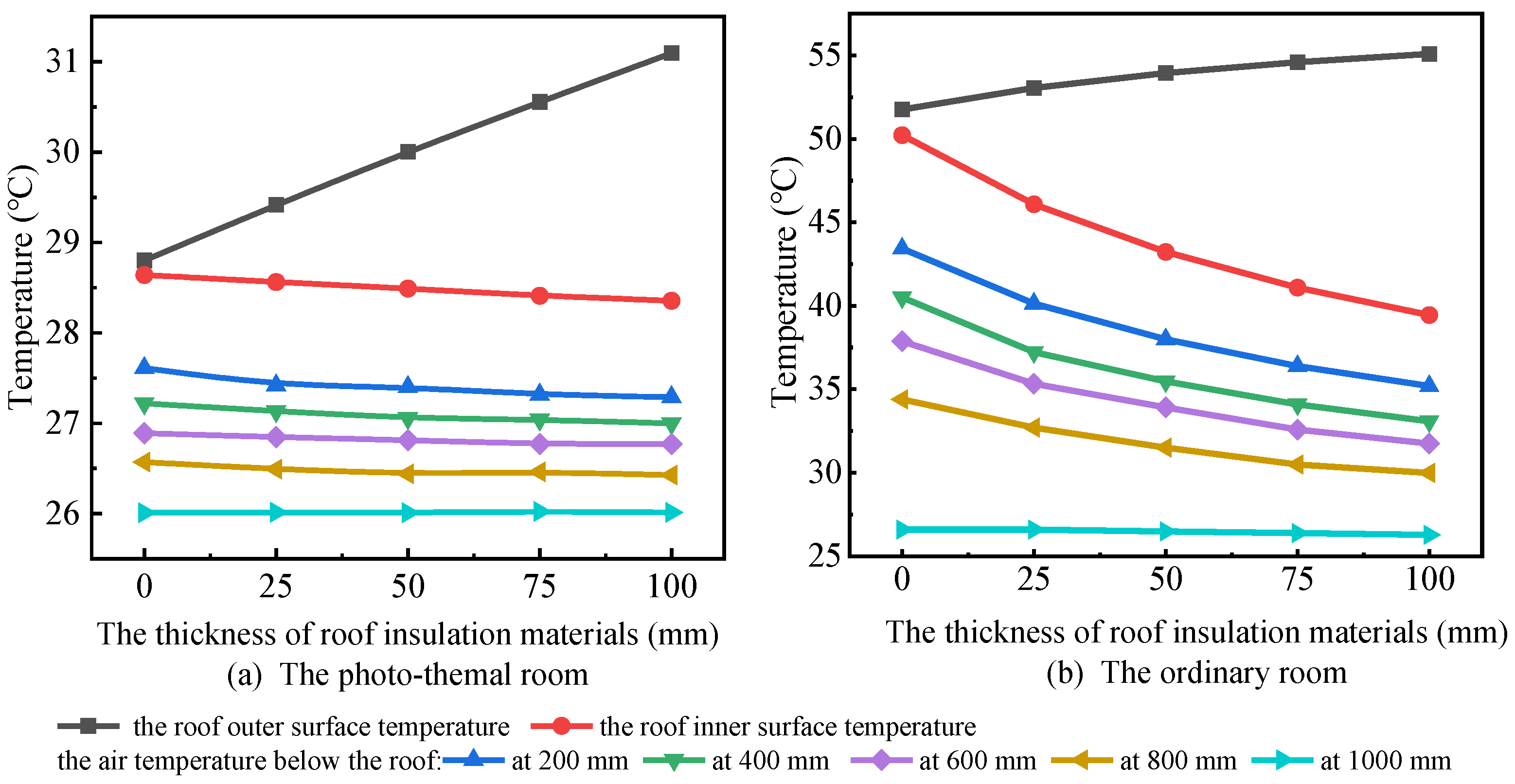

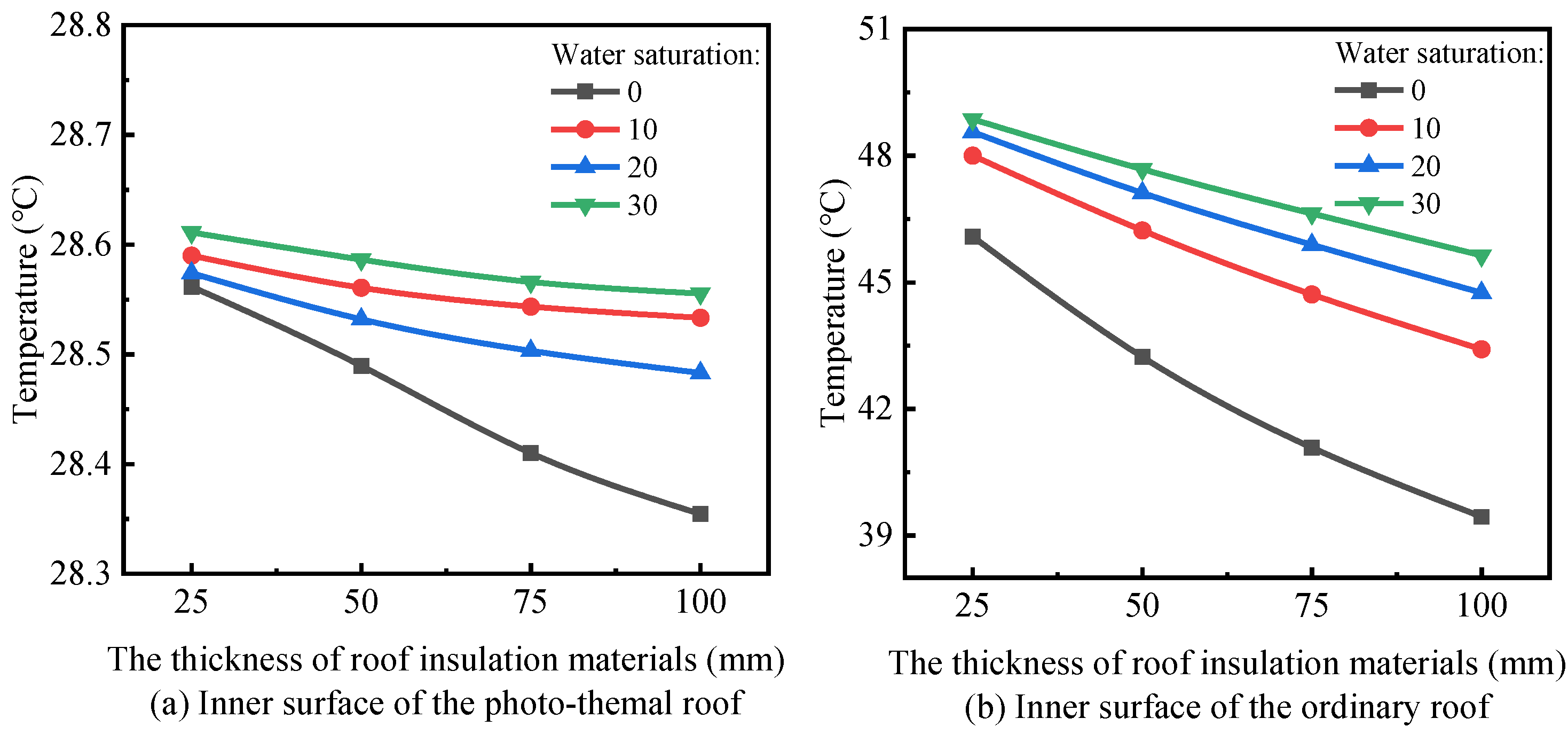
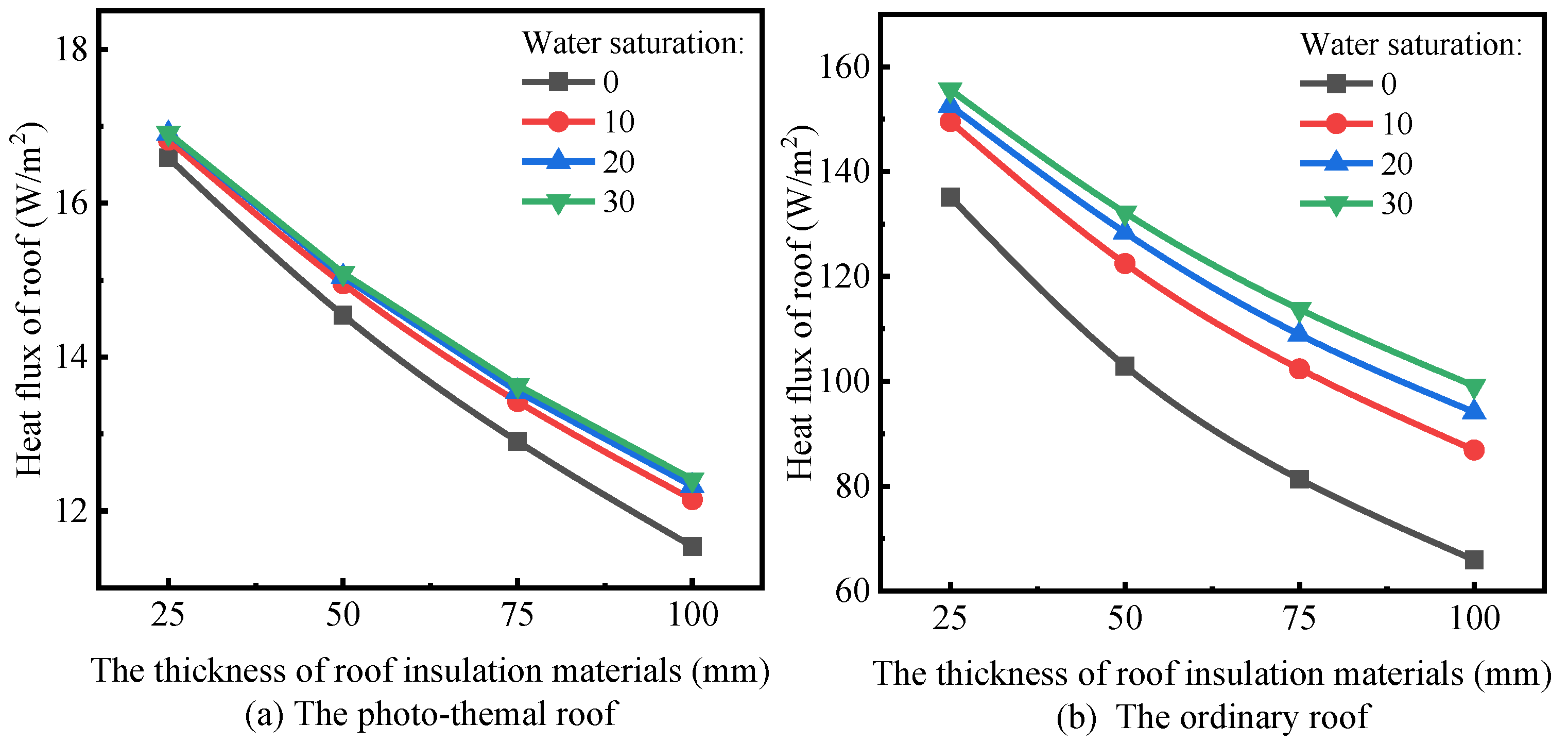

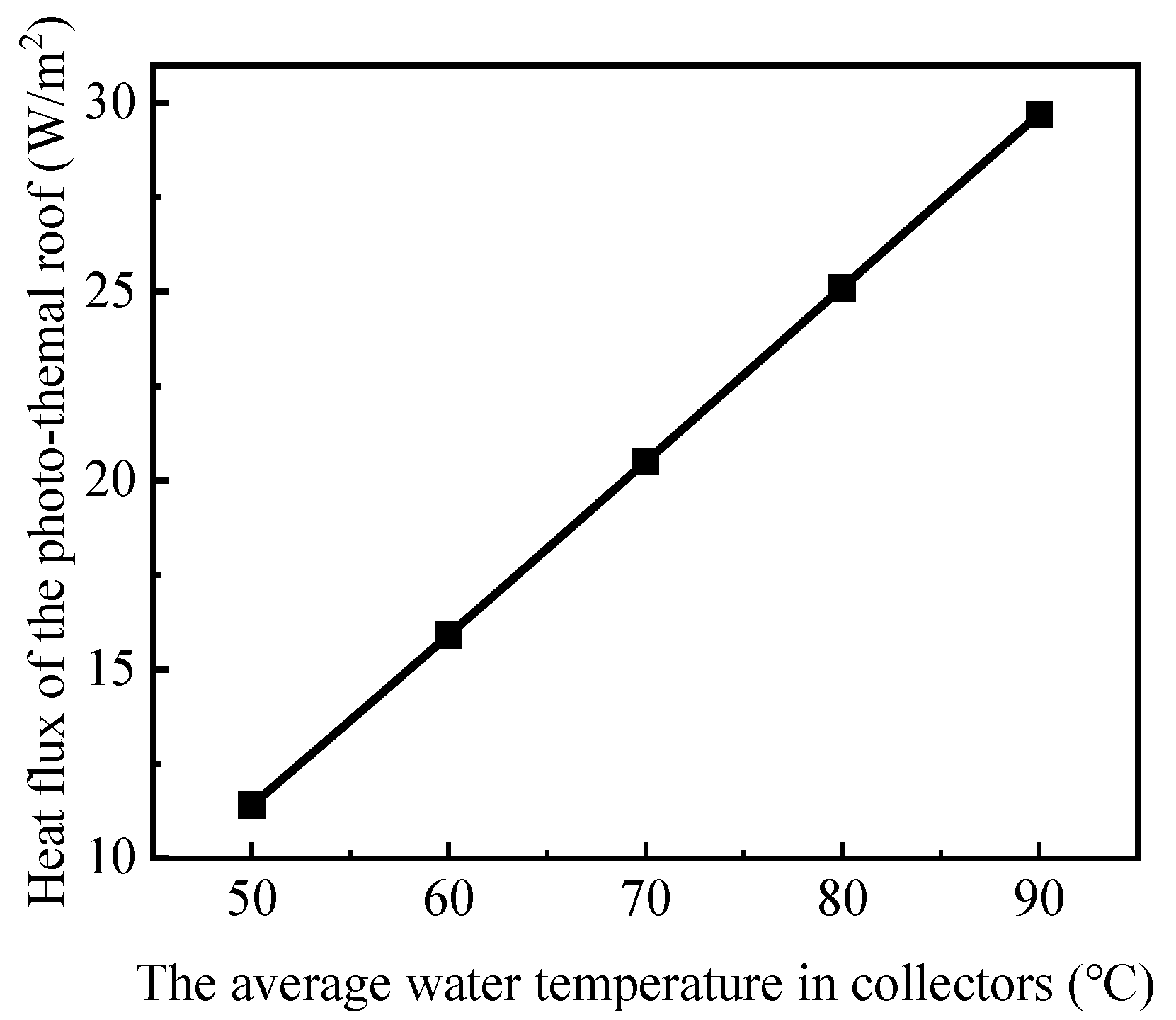
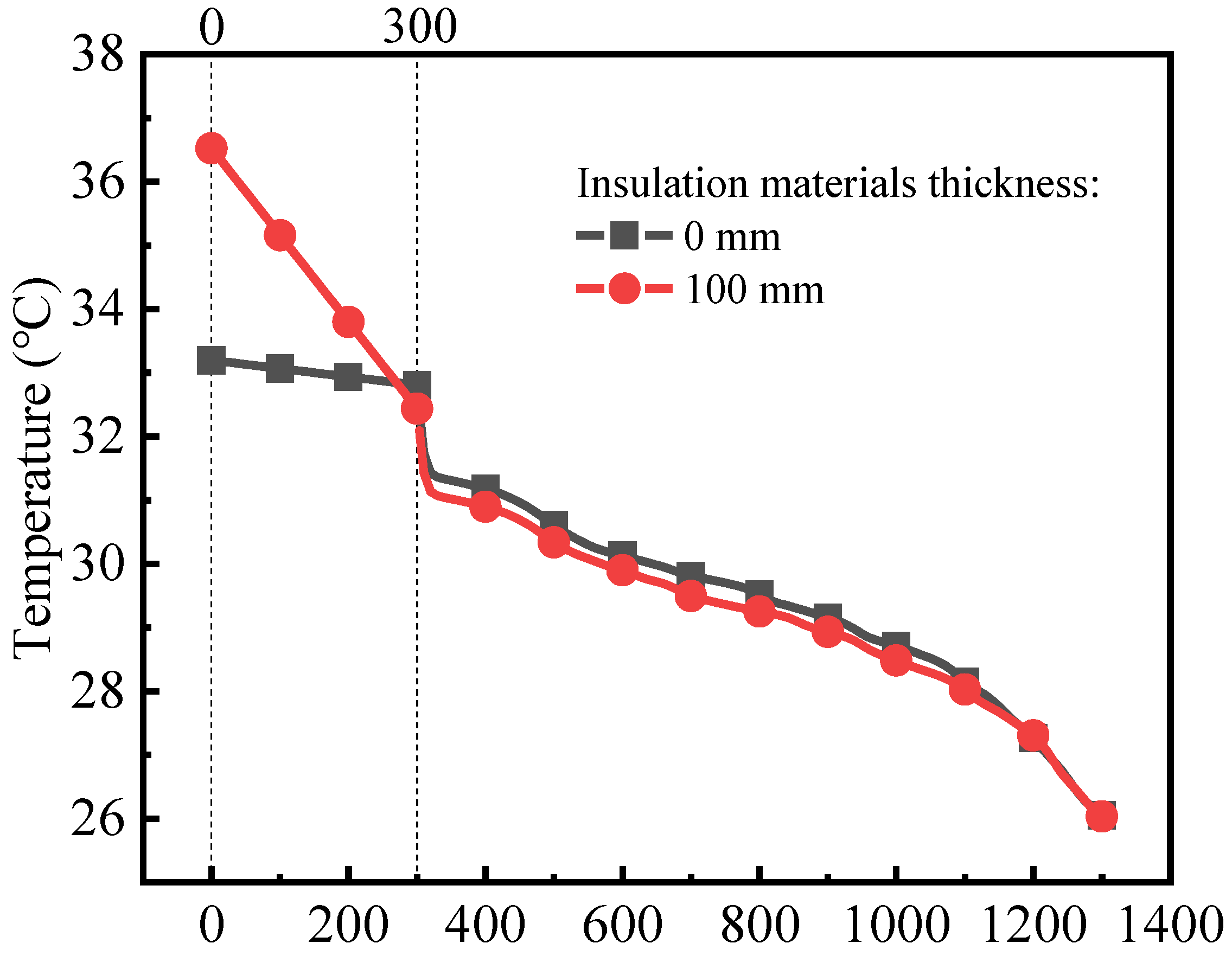
| Test Parameters | Test Instrument | Type | Accuracy |
|---|---|---|---|
| Solar radiation intensity | Solar pyrometer | TBQ-2 | ≤0.2% |
| Temperature | Thermocouple | Ni-Cr and Ni-Si | ±0.5 °C |
| Data acquisition unit | XSR-70A | ≤0.2% |
| Material Layers | Size | Density (kg/m3) | Specific Heat Capacity (J/(kg·K)) | Thermal Conductivity (W/(m·K)) |
|---|---|---|---|---|
| x × y × z (mm3) | ||||
| Glass cover | 1000 × 2000 × 4.5 | 2500 | 840 | 0.76 |
| Air layer in collector | 1000 × 2000 × 45 | 1.205 | 1005 | 0.026 |
| Absorber plate | 1000 × 2000 × 1.5 | 2719 | 871 | 202.4 |
| Copper pipe | 8 × 2000 × 8 | 8978 | 381 | 387.6 |
| Insulation in collector | 1000 × 2000 × 55 | 50 | 1380 | 0.04 |
| Air layer | 4000 × 5000 × 100 | 1.205 | 1005 | 0.026 |
| Reinforced concrete layer | 1000 × 2000 × 160 | 2500 | 860 | 1.73 |
| Insulation layer | 1000 × 2000 × δ | 120 | 750 | 0.04 |
| Cement mortar layer | 1000 × 2000 × 40 | 2000 | 840 | 0.87 |
| Boundary | Type | Value | Remarks |
|---|---|---|---|
| Glass cover | Convective heat transfer surface | αg = 0.12 τg = 0.8 | Introduction of solar radiation from the solar ray tracing model. |
| Absorber plate | Coupling surface | αp = 0.95 | - |
| Copper pipe | Temperature surface/Coupling surface | 50 °C/- | The temperature of the pipe was kept constant by adjusting the water flow. |
| Insulation in collector | Coupling surface | - | - |
| Outside surface of the photo-thermal roof | Coupling surface | - | - |
| Outside surface of the ordinary roof | Mixed | αw = 0.6 | - |
| Inner surface of roofs | Coupling surface | - | - |
| Contact surface between air-conditioned area and non-air-conditioned area | Coupling surface | - | - |
| Solar Radiation Intensity (W/m2) | Ambient Temperature (°C) | Wind Speed (m/s) | Sky Temperature (K) |
|---|---|---|---|
| 1000 | 35.8 | 2.6 | 296 |
| Comparison of Simulation and Experimental Results | Ordinary Roof Outer Surface Temperature | Ordinary Roof Inner Surface Temperature | Photo-Thermal Roof Outer Surface Temperature | Photo-Thermal Roof Inner Surface Temperature |
|---|---|---|---|---|
| Experimental values | 53.0 | 43.2 | 37.0 | 36.8 |
| Simulation values | 51.3 | 39.7 | 33.5 | 32.7 |
| RE (%) | 3.2% | 8.1% | 9.5% | 11.1% |
| RMSE | 3.3 | |||
Publisher’s Note: MDPI stays neutral with regard to jurisdictional claims in published maps and institutional affiliations. |
© 2022 by the authors. Licensee MDPI, Basel, Switzerland. This article is an open access article distributed under the terms and conditions of the Creative Commons Attribution (CC BY) license (https://creativecommons.org/licenses/by/4.0/).
Share and Cite
Zhang, Y.; Sun, H.; Long, J.; Zeng, L.; Shen, X. Experimental and Numerical Study on the Insulation Performance of a Photo-Thermal Roof in Hot Summer and Cold Winter Areas. Buildings 2022, 12, 410. https://doi.org/10.3390/buildings12040410
Zhang Y, Sun H, Long J, Zeng L, Shen X. Experimental and Numerical Study on the Insulation Performance of a Photo-Thermal Roof in Hot Summer and Cold Winter Areas. Buildings. 2022; 12(4):410. https://doi.org/10.3390/buildings12040410
Chicago/Turabian StyleZhang, Ying, Hongfa Sun, Jibo Long, Li Zeng, and Xiaohang Shen. 2022. "Experimental and Numerical Study on the Insulation Performance of a Photo-Thermal Roof in Hot Summer and Cold Winter Areas" Buildings 12, no. 4: 410. https://doi.org/10.3390/buildings12040410
APA StyleZhang, Y., Sun, H., Long, J., Zeng, L., & Shen, X. (2022). Experimental and Numerical Study on the Insulation Performance of a Photo-Thermal Roof in Hot Summer and Cold Winter Areas. Buildings, 12(4), 410. https://doi.org/10.3390/buildings12040410






